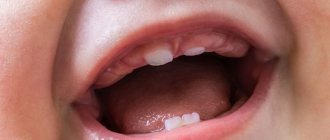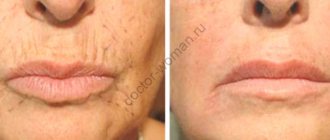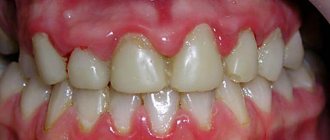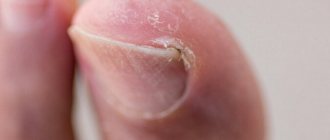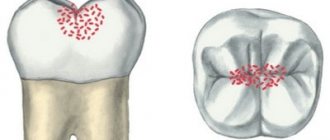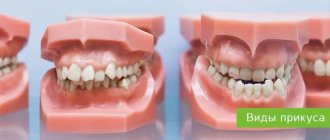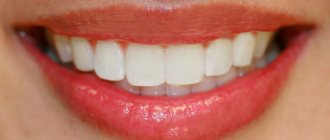Structure and functions
The tongue is a muscular organ without bones, covered with a mucous membrane.
Main functions:
- is directly involved in the pronunciation of sounds;
- determines the taste of what a person eats and drinks;
- is an integral element of the digestive system - it carries out the primary processing of food before it enters the esophagus.
The structure of the organ is quite simple, but very interesting. The tongue is divided into two parts: the back - the root and the front - the body or, as it is also called, the back, which has a velvety structure. The top is covered with papillae, which are responsible for taste buds.
Anatomy of the human tongue
The mucous membrane, penetrated by blood vessels, contains taste buds, glands, and lymphatic formations. It is covered with four types of papillae:
- Thread-like - oblong in shape, performing tactile functions by holding food.
- Mushroom-shaped, located everywhere except the apex and middle of the body. Responsible for the perception of taste.
- The leaf-shaped ones are located on the side and serve as taste analyzers.
- Grooved - large formations near the root, taste receptors.
The number of papillae is an individual value. Those who have a small amount often experience hunger, having difficulty sensing the characteristics of food.
Products interact with receptors that recognize sweet, bitter, sour, salty tastes, transmitting corresponding impulses to the brain. Full sensations arise when the senses of smell, touch, and vision are connected. Previously, it was believed that one group of receptors reacts to a specific taste, but this is misleading.
Fun fact : Women are more sensitive to sweet foods. The peculiarity is explained by the large number of receptors in the fair half.
The main component of the organ is muscles that provide mobility in different directions.
- Skeletal, originating from the bones - temporal, hyoid, lower jaw.
- Own, capable of changing shape and providing movement.
Another component is the salivary glands located near the root of the tongue (posterior) and the tip (anterior).
What a healthy tongue should look like
A healthy tongue should be pink and have a fold along its surface. It should be soft upon palpation and should not hurt when moving in different directions. The taste buds on the organ should be clearly visible. A small amount of white plaque does not always indicate the presence of any pathology; as a rule, this is the norm. A significant accumulation of plaque on the tongue may indicate the development of the following diseases:
- caries;
- gingivitis and other periodontal diseases;
- candidiasis.
Also, the cause of white or yellow plaque can be gastrointestinal diseases, food allergies or lack of vitamins. Plaque thickening may signal a chronic disease.
Ulcers and wounds on the tongue
Ulcers on the surface of the tongue are not uncommon and can occur for a variety of reasons:
- tongue injury;
- burn;
- dental problems in the oral cavity;
- Crohn's disease and other gastrointestinal problems.
Usually the ulcers are small in size, but present in large numbers, so they cause a lot of inconvenience and discomfort to a person. It is impossible to ignore wounds and ulcers on the tongue, especially if they arise without a reason.
One of the types of disease in which the body gives such a symptom is syphilis, therefore, treatment should be immediate and professional. However, in the case of this disease, the ulcer will be present on the tongue in the singular.
Its surface is bright red, shiny and hard. In addition, it is completely painless. The formation of warts at the root of the tongue or on its sides is a sign of HIV, and flat ulcers on the tip of the tongue, the sides or along the midline indicate the onset of tuberculosis.
Differences by color
Many people know that by the color of the tongue one can understand that something is wrong with the body. It is not a myth that some diseases are reflected on the tongue by a characteristic shade of plaque.
Let's look at the most common ones:
- influenza accompanied by high body temperature - burgundy coating;
- heart problems, anemia, malnutrition – pale color;
- blood diseases and pathologies of the respiratory system - purple tint;
- gastrointestinal diseases, jaundice or smoking - gray or yellow color;
- problems with the liver or spleen, dysentery, advanced viral diseases, abscess - black plaque;
- kidney pathologies – bluish tint;
- circulatory disorders, heavy metal poisoning – blue color;
- fungal infection and general dehydration of the body - white plaque;
- dental diseases – whitish or dark brown color.
How to keep your tongue healthy
The tongue, like teeth, is visible to others, and if it looks unhealthy, you may feel self-conscious. If your dentist or therapist has already determined that the discoloration of your tongue is not due to disease, you can improve its appearance by gently brushing your tongue twice daily during your normal oral hygiene routine. Use a toothbrush with a special scraper or pad to clean your tongue and cheeks.
Also, get into the habit of sticking out your tongue and examining it after brushing your teeth, this will allow you to immediately notice changes in its color or detect other problems. However, you need to understand that a healthy tongue color does not guarantee good dental health. Remember to visit your dentist regularly to check the health of your teeth, gums, and overall mouth.
Functions
The tongue is not only an organ of taste, but a participant in several types of human activity, performing important functions:
- movement of food into the esophagus;
- primary digestion of saliva enzymes;
- sound production;
- protection against infection;
- absorption of certain medications (sublingual administration).
Papillae of the tongue.
The organ is important in infancy: with its help, sucking occurs - the only way the baby receives nutrients.
Sources
- Tsepov L. M., Tsepova E. L. Lesions of the mucous membrane of the mouth and tongue in persons with pathology of the gastrointestinal tract // Bulletin of the Smolensk Medical Academy. No. 1. 2011.
- Sakharuk N.A. Oral candidiasis // Bulletin of VSMU. Volume 6. No. 1. 2007
- Agaev I. A. Language is the mirror of the body // Biomedicine. 2/2010.
- Makedonova Yu. A., Poroisky S. V., Gavrikova L. M., Afanasyeva O. Yu. Manifestation of diseases of the oral mucosa in patients who have had Covid-19 // Bulletin of Volgograd State Medical University. Issue 1 (77). 2021
How to get rid of plaque
A small white coating that appears on the tongue after a night's sleep can be easily removed during morning hygiene procedures. But if it cannot be removed, it completely covers the taste buds and constantly appears again, then this is already regarded as a sign of a disease of the internal organs. Treatment in this case is prescribed by a doctor after examination and an accurate diagnosis.
You need to brush not only your teeth, but also your tongue. It is better to use a special scraper. Photo: AndreyPopov / Depositphotos
For diseases of the gastrointestinal tract, drug therapy may include antiulcer drugs, drugs that improve digestive processes, and normalize the composition of intestinal microflora. Dietary nutrition is recommended. Spicy and fatty foods are excluded from the diet. Limit sweets. Food is taken in small portions 5-6 times a day. Depending on the location of the inflammatory focus and the severity of clinical manifestations, the diet is adjusted by the doctor.
Infectious diseases are treated with antibiotics. To reduce the activity of the inflammatory process, non-steroidal anti-inflammatory drugs are included in the treatment regimen.
Red tipped tongue
The tip of the tongue corresponds to the area of the heart. If you do not have any signs of illness, a red tip of your tongue may indicate emotional problems.
Loss of the ability to counteract and regulate thermogenic hormones is usually indicated by a bright red tongue. This is typical for men who, for some reason, take hormonal drugs, or women who are entering menopause.
Prevention
Prevention of tongue cancer involves reducing exposure to risk factors and regular dental checkups. In order to minimize the likelihood of developing this disease, it is necessary to give up smoking and alcohol abuse, as well as the use of chewing mixtures. Monitor your oral health carefully. Chronic injury to the tongue should not be allowed; teeth must be treated and dentures adjusted in a timely manner. If long-term (more than 2 weeks) formations are detected, you definitely need to consult a doctor as soon as possible. [1.7]
| More information about treatment at Euroonco: | |
| ENT oncologists | from 5,100 rub. |
| Chemotherapy appointment | RUB 6,900 |
| Emergency oncology care | from 12,100 rub. |
| Palliative care in Moscow | from 44,300 rubles per day |
| Radiologist consultation | RUB 11,500 |
Book a consultation 24 hours a day
+7+7+78
Bibliography:
- Clinical recommendations. — Malignant neoplasms of the oral cavity. Ministry of Health of the Russian Federation. — 2022.
- MM. Soloviev. — Practical Oncology • T. 4, No. 1 – 2003, Cancer of the mucous membrane of the oral cavity and tongue (reserves for improving treatment results), 2003
- A.L. Yudin. — Cancer of the tongue and floor of the mouth: modern aspects of diagnosis — Bulletin of Radiology and Radiology No. 5, 2015.
- Clinical protocol for diagnosis and treatment. — Malignant neoplasms of the oral cavity. The Republic of Kazakhstan. — 2015.
- Malignant tumors of the organs of the mucous membrane of the oral cavity and tongue. Educational method. manual./O.P. Chudakov, L.E. Moiseichik, T.B. Lyudchik, L.G. Bykadorova. - Mn.: BSMU, 2007. - 39 p.
- V.A. Soloviev. — Possibilities of ultrasound diagnosis of tumors of the tongue and floor of the mouth. — Oncology. Journal named after P.A. Herzen, 4, 2015. doi: 10.17116/onkolog20154418-21.
- A.R. Gevorkov. – Independent conservative and combined treatment of tongue cancer. – Oncology. Journal named after P.A. Herzen, 4, 2014.
- Rodrigo Arrangoiz. — Oral Tongue Cancer: Literature Review and Current Management. - Сancer Rep Rev, 2022. - Volume 2(3): 1-9. - doi: 10.15761/CRR.1000153.
Is it worth diagnosing by tongue?
Doctors have been studying the question of what diseases can be identified by language for several hundred years. The results of research by ancient and modern scientists show that this connection exists, but it must be properly understood and assessed. If a healthy person has irregularities or the color of the plaque has changed, this phenomenon may be the very first symptom of a disease that will manifest itself in the future with other abnormalities.
There is an assumption that the imprints of the disease appear on this organ several days before its clinical signs, but you should not use diagnosis by a person’s tongue for further self-medication. This is a whole science, and only a good specialist can understand it. Treatment can begin only after a full examination and establishment of a correct diagnosis.
Diagnostic Tool
The language, whose structure is complex, is an indicator of the state of the body. The following diseases are suggested by their appearance:
- yellow plaque indicates gastrointestinal diseases;
- trembling of the tip is a sign of neuroses, diseases of the nervous system;
- cracks are a symptom of digestive pathologies;
- deepening of the furrow is a symptom of a back problem;
- metabolic disorders - dry mucosa;
- light ulcers occur with gastritis, accompanied by high acidity;
- a bright, shiny surface is a sign of high temperature, infection;
- white plaque signals candidiasis and stomatitis.
A healthy back is smooth, velvety, pale pink in color. It does not leave the teeth, is moist, and has an even, straight central groove. Plaque appears due to anaerobic bacteria accumulating on the mucous membrane. An effective remedy is daily brushing with a toothbrush.
Sources:
- Kurepina M.M., Ozhigova A.P., Nikitina A.A. Human anatomy. Moscow, 2010.
- Fed.kovich N. Anatomy and physiology of man. Tutorial. Rostov-on-Don, 2003.
